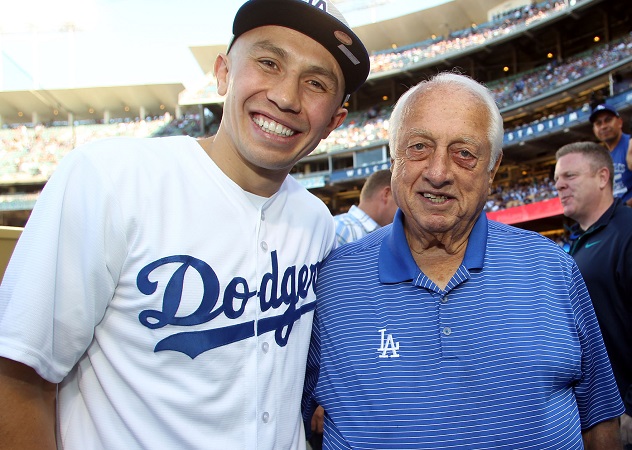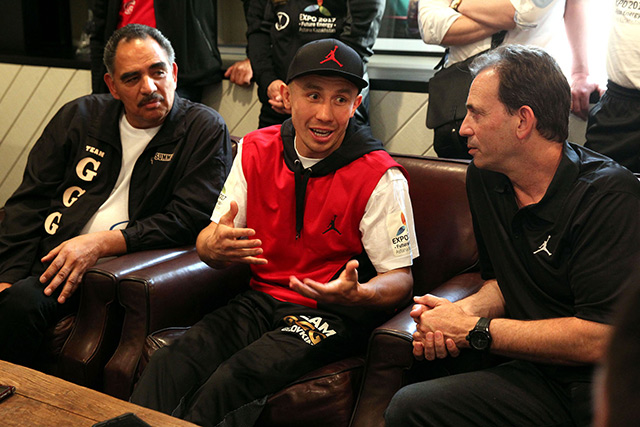Gennady Golovkin’s rise reflects Pacquiao playbook


Gennady Golovkin, decked out in Jordan Brand attire, addresses media flanked by trainer Abel Sanchez (L) and promoter Tom Loeffler. Photo: Chris Farina/K2
Before his fight with David Lemieux last October, a strange thing happened to Gennady Golovkin.
He was booed. Well, maybe not Golovkin but the man by his side was booed. While the Kazakhstani boxer got loose in the Knicks locker room, he received a visit from a man in a dark suit, blue tie, orange skin and helmet-like hair.
Images of Golovkin and Donald Trump shaking hands in the dressing room flashed on the huge video board high above the ring. Though Golovkin was in the frame, so was Trump. Thus, a cascade of boos followed. The scene wasn’t exactly groundbreaking. Celebrities have forever visited fighters in dressing rooms. But the scene did call to mind another political gathering. Manny Pacquiao was approached by Mitt Romney in the dressing room in Dec. of 2012 before he fought Juan Manuel Marquez.
“Hi Manny, I’m Mitt Romney,” the former Massachusetts governor said. “I ran for president. I lost.”
Of course, Golovkin and a prime Pacquiao have more in common than celebrity groupies. There’s the violent knockouts, the angelic smiles after fights, the humbleness that bordered on shyness early in their careers.
And there’s the way their public image has been marketed and crafted to an adoring public ready to pounce. As Golovkin (34-0, 31 knockouts) defends his WBA and IBF middleweight titles against Dominic Wade tonight at The Forum in Inglewood, California, on HBO, it seems appropriate to assess Golovkin’s standing in the public mind and how similar his rise is to Pacquiao’s in the way they were promoted.
Golovkin’s bout against the unknown Wade (18-0, 12 KOs) is expected to sell out despite the one-sidedness of the matchup. He can’t go anywhere without someone mentioning a potential superfight with Canelo Alvarez. He’s been omnipresent in media reports, showing up at Cowboys Stadium as a guest of owner Jerry Jones; breaking camp last month to visit racing legend Dale Earnhardt Jr. at a NASCAR event; signing with Nike’s Jordan Brand. He has never been more popular, and it’s not by accident. Golovkin’s recent out-of-the-ring success is the result of an intense marketing push by his handlers that seems eerily familiar.
While promoter Tom Loeffler and publicist Bernie Bahrmasel haven’t outright plagiarized the playbook used by Top Rank and publicist Fred Sternburg to market Pacquiao in the cultural marketplace in his halcyon days, they acknowledge they’ve been inspired by those efforts. Pacquiao eventually rose to the point where he graced the cover of Time magazine with the headline, “The Great Hope.”
“I think there are a lot of parallels between Manny’s career in the United States and Gennady’s career,” Loeffler told RingTV.com. “They’re both very charming. Both have great personalities. Both likeable guys. Both offensive fighters in terms of providing excitement and providing knockouts.”
Loeffler and Bahrmasel were quick to point out differences in the fighter’s timelines – Pacquiao had a rabid U.S. fan base in his Filipino countrymen to rely on and Golovkin hasn’t had that career-defining fight yet. But the two also credited Top Rank’s ability to successfully sell a foreign-born boxer with limited English and charisma to an American audience, challenges they now face with Golovkin.
Golovkin’s handlers have tried to make Golovkin as visible as possible in between fights and encouraged the types of meetings with celebrities that can produce cultural touchstone moments – such as his brief get-together with Trump. Pacquiao did the same in his day with duets with Will Ferrell and frequent appearances on late-night talk shows. Both Top Rank, as well as Loeffler and Bahrmasel saw early they had boxers who could disarm with just a smile, and they put them to work in a myriad of public appearances, all with the goal of humanizing these hurt-machines.
“I don’t think it was a playbook I followed but you can certainly be inspired by someone else’s work and be inspired by the ideas,” Bahrmasel told RingTV.com of Top Rank and Sternburg. “Not that you want to use the same ideas. But there’s no question about it, I was inspired by Freddy.”
Added Loeffler, “We didn’t pattern the strategy after Manny’s appeal but in hindsight there are a lot of parallels to the ascension of popularity to both Manny and Gennady.”
_____________________________
Sternburg is credited in large part with helping launch Pacquiao into the stratosphere until his retirement earlier this month. The end wasn’t easy. Pacquiao angered many with his anti-gay comments as he ran for a Senate seat. Nike dropped him, and the PPV numbers for his third bout with Tim Bradley were pedestrian – between 400,000 and 500,000 – compared to his previous efforts.
Still, Sternburg was his usual, upbeat self as he sought to portray Pacquiao as the affable, fun-loving guy who destroys people for a living. As the sport moves on to the next generation, Sternburg has watched from afar as Team Golovkin has tried to give rise to another global symbol. They still have a long ways to go — Golovkin’s HBO PPV bout with David Lemieux did just over 150,000 buys – but Sternburg sees some of the same traits in Golovkin that allowed Pacquiao to be so successful in connecting to general fans.
“If they can communicate and convey his personality, which to me it seems like he’s got a good one — that’s the key for everything,” Sternburg said. “With Manny, he really wanted to learn English, even when he wasn’t comfortable with it. If Golovkin continues with his lessons in English, it will only increase his his commercial appeal. And then you can get him on these mainstream shows.”
Pacquiao became a regular on Jimmy Kimmel Live! and raked up endorsement deals with Foot Locker, Wonderful Pistachios, Nestle’s Butterfinger and many more in the Philippines. The diminutive Filipino earned $160 million in 2015, placing him second on the Forbes highest-paid athlete lists.
Golovkin’s endorsement portfolio has increased in recent years, as well. Loeffler noted he’s made deals with Apple Watch, Samsung, Tecate beer, Nike and scores of businesses in his native Kazakhstan. The next frontier is to market Golovkin to Korea, where his grandfather was born, Loeffler said.
“They realize that Gennady is not going to be at a bowling alley at 3 in the morning getting into a fight,” Loeffler said of the sponsors, referencing Adrien Broner, who was involved in an alleged assault near a bowling alley in January. “They understand his character outside the ring and also his universal appeal inside in the ring.”
There’s even talk of recruiting Golovkin into politics in his native Kazakhstan, where officials have reached out to him to gauge his interest, Loeffler said. But for the time being, Golovkin doesn’t seem to have any political aspirations as Pacquiao did.
All that’s missing for Golovkin, Sternburg says, is the right opponents for him to further his bona fides. “I think Golovkin, if he’s lacking in anything, it’s that definitive fight, which will come,” Sternburg said. “You just don’t know when and it’s not for a lack of trying for sure. But who the heck wants to get in the ring with him?”
__________________________________
Up until 2012, television analyst Larry Merchant had a front-row seat to the Pacquiao spectacle as an on-air commentator. Now 85, Merchant has watched Golovkin’s rise from the comforts of his home.
Merchant believes Pacquiao created a template of sorts for non-American fighters to follow as they attempt to market themselves to a stateside audience. Pacquiao showed that it could be done, from the style of fighting to the way he handled himself outside the ring. He emboldened “other foreign fighters to see if they could emulate him in some way,” Merchant told RingTV.com. “And I think that maybe there are the Russian fighters who came here and they understood, got the vibe of him that if you came here you had to be a fighter (to create interest).”
Part of Golovkin’s spike in popularity has to do with his Mexican fan support, Merchant said. Just as Pacquiao drew fans after his wins against Mexican folk heroes like Erik Morales and Marco Antonio Barrera, Golovkin has done the same with his aggressive style of boxing. But Merchant remains skeptical that Golovkin, 34, will ever be able to approach the massive appeal of Pacquiao, who generated over $700 million in PPV revenue in his career.
“I think it’s unfair,” Merchant said of comparing Golovkin to Pacquiao. “Everybody has their own path, their own fingerprint. It’s unlikely he’s going to touch a nerve in the Russian or Soviet communities the way Manny did among Filipinos here. And the fact that most of his opponents are not very well known and whereas Manny was fighting Morales three times and Barrera twice and Marquez (four) times and then De La Hoya and Mosley and Cotto. So that’s sometimes a matter of being in the right place at the right time. Or making it the right place or time. We’ll see whether Golovkin can do that.”
















